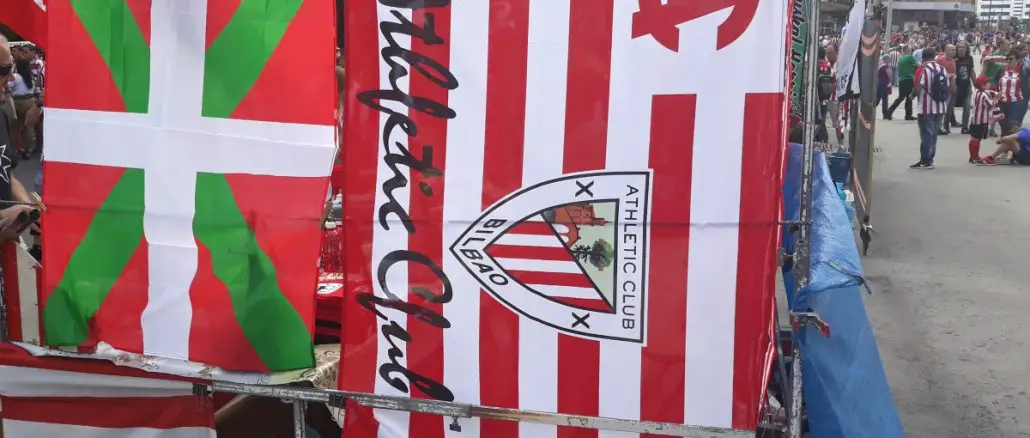
Our Basque football guide heads deep into the heart of a region that was in many respects the birthplace of football in Spain, with Basque clubs playing a vital role and enjoying considerable success during those formative years.
Despite only accounting for just 1.4% of all Spanish territory, four of the 10 founding members of the inaugural Spanish league in 1929 were from the tiny Basque region. Basque clubs and particularly Athletic Club had already been dominant during the early years of the Copa del Rey, and a century on, while it may not boast such a stranglehold on the Spanish game these days, the Basque Country continues to punch above its weight on the football field with three top-flight clubs in 2025/26.
That’s excluding Pamplona-based Osasuna who are another LaLiga side that to some extent identifies as Basque, and does fall within the wider definition of the Basque Country which also extends into France. However, Pamplona is based within Navarre rather than the Basque Country in terms of its status among Spain’s 17 autonomous communities.
Basque Country football map
This is a compact and quite densely-populated region in the far northwestern corner of Spain. Towns and cities usually have separate names in Spanish and the Basque language (Euskara) which is extremely unique and totally unrelated to Spanish or indeed any other European language.
The largest city and biggest metropolitan area is Bilbao (Bilbo). Athletic Club are located in the centre of the city and are historically the biggest and most successful of the clubs in the region. Also in the metropolitan area of Bilbao, in the area immediately north of the city you will find third-tier sides Barakaldo and Arenas.
It’s about 100 km by road from Bilbao to San Sebastian (Donostia), the home of Real Sociedad, the Basque Country’s second most famous club. On the main highway between the cities, you also pass through Amorebieta-Etxano, home of SD Amorebieta who have just suffered back-to-back relegations to drop into the Segunda Federacion (fourth tier), as well as the small town of Eibar which is currently home to Segunda Division football having hosted LaLiga action for much of the 2010s.
Eibar is slightly closer to Bilbao, but is in the province of Gipuzkoa as opposed to Bizkaia. Along with Real Sociedad and Eibar, the other Gipuzkoan team of note is historic Real Union, in the town of Irun. Their stadium is just 500 metres from the Bidasoa river which forms the border between Spain and France.
The other Basque province is Alava, directly to the south of Bizkaia and Gipuzkoa. Its capital is Vitoria (Gasteiz) and it is home to Deportivo Alaves, the other top-flight team from this fiercely proud region.
Basque football teams
The Big two
Athletic Club
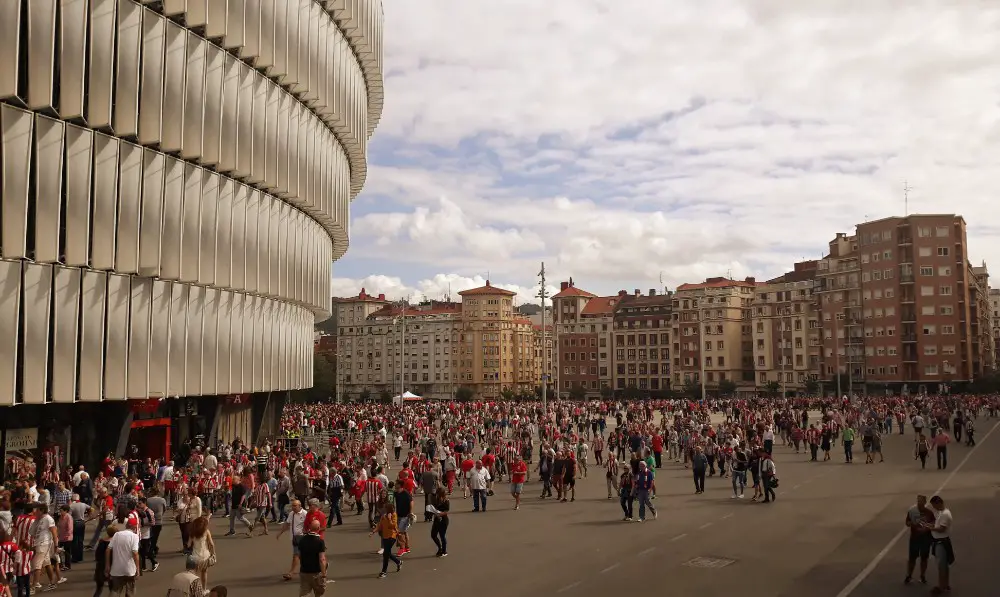
Stadium – San Mames
Capacity – 53,289
Nearest station – San Mames (Bilbao Metro)
With 8 league titles and 24 Copa del Rey triumphs, Athletic are the third-most successful club in Spanish football history. They retain a special aura, largely thanks to their almost completely unique policy of only signing Basque players, or at least those who progressed through Basque academies as a youngster.
Unsurprisingly, that has made it tough for Athletic to compete for silverware during recent decades when elite foreign players have flooded into the Spanish game to bolster the top clubs, but remarkably given the small talent pool they have to choose from, Athletic have never been relegated from the top flight. They’re going through a good period currently, having won the Copa del Rey in 2024 and qualified for the Champions League in 2025.
How to buy tickets for Athletic matches:
Tickets for Athletic matches can be bought online via the club’s website. Despite the large capacity of over 50,000, bigger matches such as those against Barcelona, Real Madrid or Real Sociedad may sell out, as may big cup ties or European fixtures. It’s advisable to pay attention to general-sale dates and look to buy as soon as possible. Alternatively, you may also have some luck finding resale seats at San Mames on Hellotickets or via footballtravel.com.
San Mames is very centrally located in the heart of Bilbao close to the port area. It is on the same site as the old San Mames which was Athletic’s home for exactly 100 years until the new stadium opened its doors in 2013. It is easily accessible by metro, however walking to the game down the iconic Calle Poza is highly recommended with the street flooded with Athletic fans eating pintxos and drinking in the many bars prior to and after the game.
You can also learn about the club’s incredible history as the early trail-blazers for football in Spain in the club’s excellent museum. A stadium tour + museum ticket is a reasonably-priced €15.
Real Sociedad
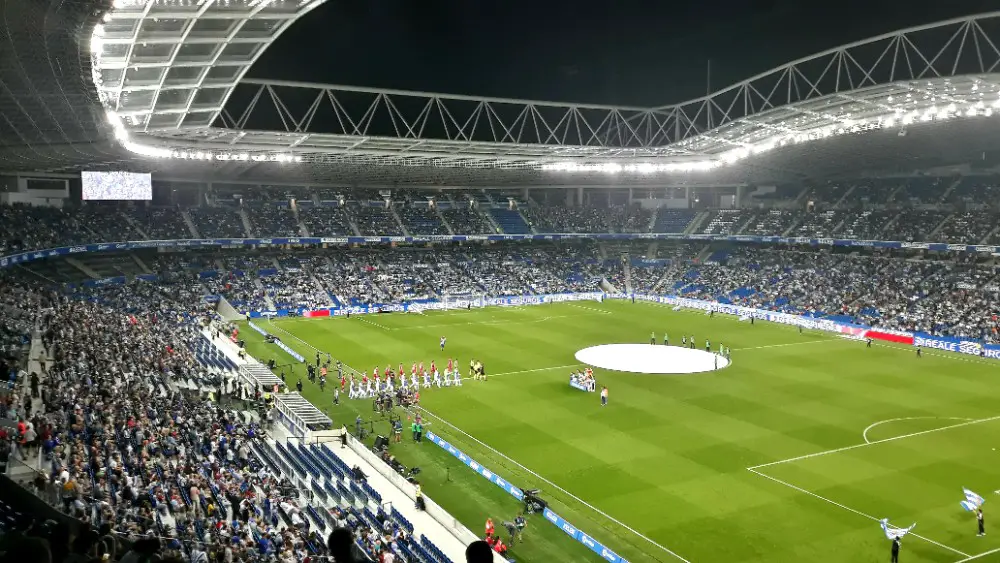
Stadium – Reale Arena
Capacity – 39,500
Nearest station – Anoeta-Donostia (Metro Donostialdea)
Real Sociedad are the other big name of Basque football. They don’t boast a trophy cabinet that can compete with that of their rivals in Bilbao, but they have had some really talented sides over the years.
Their best came during the early 1980s when they won back-to-back league titles under the management of Alberto Ormaetxea. They too had a Basque-only policy during that period, but it has since been relaxed with John Aldridge controversially becoming their first foreign player in many decades in 1989.
They’ve been European regulars in recent years, and famously defeated Athletic Club in the first Basque derby Copa del Rey final between the two sides in 2021.
How to buy tickets for Real Sociedad matches:
Anoeta was totally revamped in the late 2010s and has turned from a soulless bowl into a modern arena with fans much closer to the pitch than they were previously. The capacity has also increased to just shy of 40,000 meaning it’s usually not a problem getting tickets. La Real also have an online ticketing system enabling you to buy match tickets in advance.
The stadium is located away from the historic centre and stunning bay which the city of San Sebastian is most famous for. It would take around 30 minutes to walk to Anoeta from either but you can take the metro with Anoeta-Donostia station located immediately adjacent to the stadium.
The other Basque clubs
Alaves
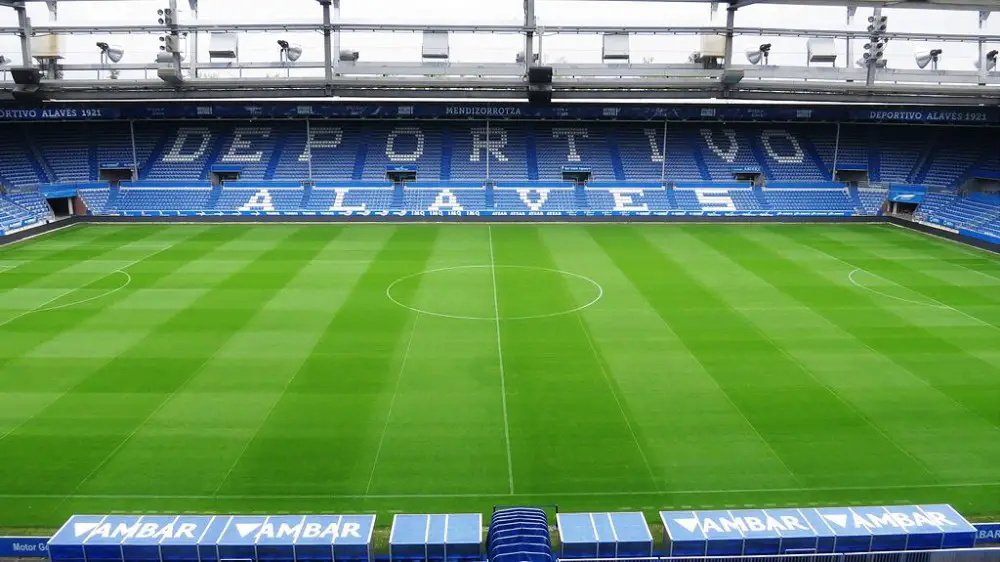
Stadium – Mendizorrotza
Capacity – 19,840
Nearest station – Vitoria-Gasteiz train station
Vitoria is home to one of Spain’s best basketball teams. Their owner Jose Antonio Querejeta, a former basketball player, bought a controlling stake in Alaves in 2013 to help the club survive an incredibly difficult period of economic turmoil and four straight seasons in the third tier.
There were times when it looked as though Alaves may go out of business altogether, but they’ve since steadily rebuilt, achieving promotion to LaLiga in 2016, before mostly reestablishing themselves in the top flight, despite briefly dropping back down to the second tier for the 2022/23 season.
Their finest hour though still remains that remarkable run to the 2001 UEFA Cup Final – one of the most extraordinary finals in European football history when Alaves suffered a 5-4 defeat to Liverpool in Dortmund.
How to buy tickets for Alaves matches:
Alaves averaged just over 17,000 for the 2024/25 LaLiga season meaning attendances do push close to their stadium’s capacity of just under 20,000. Tickets for upcoming Alaves matches can be bought online in advance, with bigger games potentially selling out.
It takes only around 20 minutes to walk to Mendizorrotza from the city’s main train station which has connections to Madrid and the other major Basque cities.
Eibar
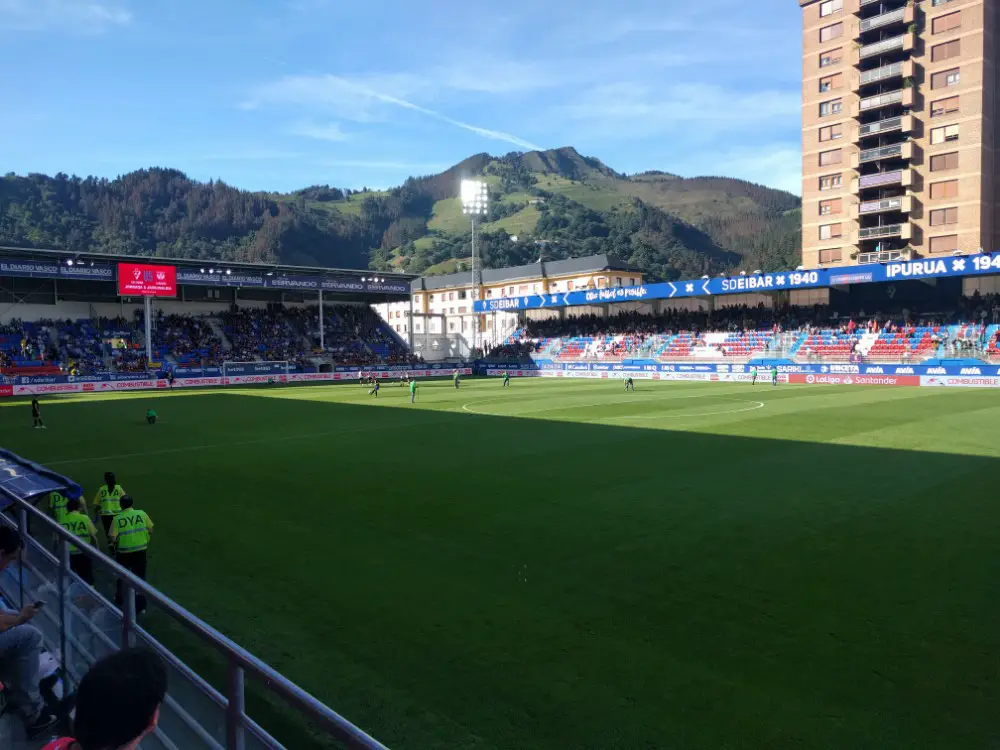
Stadium – Ipurua
Capacity – 8,164
Nearest station – Ardantza-Eibar or Amaña-Eibar
With a population of a little over 27,000, Eibar isn’t really somewhere you expect to find a top-flight football team, but led by Gaizka Garitano they achieved back-to-back promotions in 2013 and 2014 to reach LaLiga for the first time.
They defied the odds to stay there for no fewer than seven years, one of the most miraculous stories in Spanish football in the 21st Century, before ultimately dropping back to the Segunda Division in 2021. They remain a well-run club that continues to regularly challenge in the top half of the second tier.
How to buy tickets for Eibar matches:
Average gates at Ipurua are around 5,000, so it’s usually possible to get tickets for their Segunda Division fixtures. Check the ticketing section of their website for updates and release dates.
The historic clubs
The Basque Country is also the location of two historic clubs who played big roles in the early days of football in Spain at the beginning of the 20th Century. Both Real Union Club and Arenas Club de Getxo were founder members of the first Spanish league season in 1929 and both sides also got their hands on the Copa del Rey during those formative years.
Real Union were the more successful, winning the Copa four times during that period. They are based in the border town of Irun which divides the Spanish and French parts of the Basque Country. They’ve spent most of this century in the Spanish third tier and they are run by Igor Emery, brother of Aston Villa boss Unai who has a controlling stake in the club.
Arenas were in the top flight from the league’s inception in 1929 until 1935, but they have not got back there since that first relegation and have spent much of their recent history outside the top three tiers. Based in the coastal town of Getxo, in the Greater Bilbao region, their Gobela ground was rebuilt in 2004 and currently holds just 2,000. It will host Primera Federacion football in 2025/26 after the club won promotion.
The best of the rest
Also in the Bilbao area, you will find Barakaldo, another historic club with over 100 years of history. They’ve spent 30 seasons in Spain’s Segunda Division without ever winning promotion to the top flight. Their Estadio de Lasesarre is roughly the same size as that of Eibar’s ground with a capacity of around 8,000.
While Real Sociedad B will play in the 2025/26 Segunda Division, and Athletic B in the Primera Federacion, you have to dive down to the fourth tier to find more Basque football clubs.
Following relegation, SD Amorebieta will be joined by the likes of Basconia, Beasain, Gernika and Sestao River in their section of the Segunda Federacion.
If you’d rather catch some more action at a higher level to fit into a Basque football trip, you can potentially head to Pamplona to watch Osasuna, while second-tier Racing Santander are located only around an hour or so from Bilbao in Cantabria. You could even hop over into southwestern France to catch Ligue 2 action with Pau Football Club.
Groundhopping in the Basque Country – Getting around
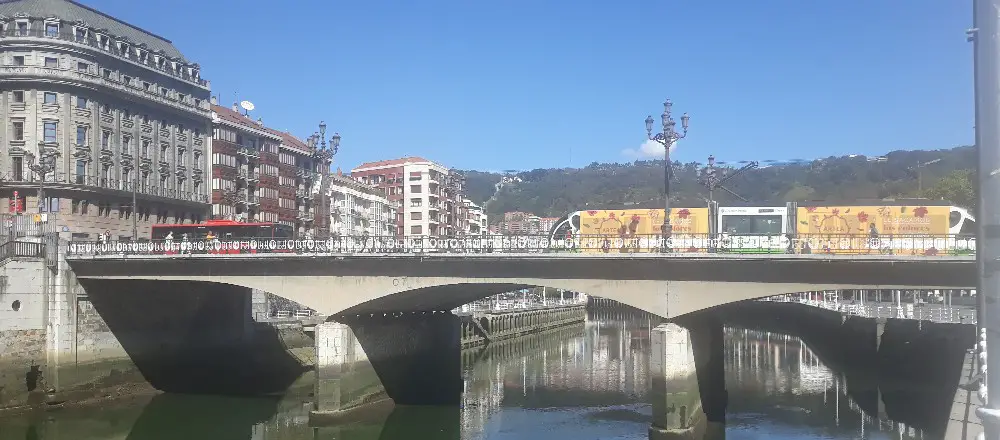
While there are a lot of clubs, the Basque Country is only a relatively small place and the vast majority of these clubs can be reached in an hour or less from Bilbao or San Sebastian with plenty of road and rail connections. Getting between Bilbao and San Sebastian is best done by bus with the fastest connections taking just over an hour with Alsa. You should be fine buying a ticket on the day of travel, although some buses do sell out during peak periods.
Bilbao’s main bus station is right next to San Mames and has good connections to towns and cities across the region. The other clubs in the Bilbao area can mostly be reached by the city’s metro network which is formed of two lines.
San Sebastian’s metro network can be used to not only reach Anoeta but Real Union’s Stadium Gal. Ficoba Irun is the nearest station to the ground, only a five-minute walk away.
Eibar does have a train station, but it is normally best reached by bus from either Bilbao or San Sebastian. Connections are pretty regular and relatively quick with the journey being less than an hour in either case. If it’s an evening game, it is worth checking to make sure you have a bus back after the match, as there is very little accommodation in Eibar itself.
Vitoria is only around 65 km south of Bilbao but the two cities are separated by mountainous terrain which makes travel between them slightly more challenging. There are bus and rail connections with the fastest buses taking around an hour. The train station is better located for the Alaves stadium though which makes the train a good option.
If you’re coming from virtually any other part of Spain, Vitoria is the easiest of the Basque cities to reach with rail and road connections meaning the journey from Madrid is possible in just under four hours in either case.
Away from the football
The Basque Country has loads to offer visitors with amazing food served up in the form of tasty pintxos, vibrant cities and scenic countryside. The only thing it lacks is great weather which is often wet and blustery, with even the summer months a bit unpredictable. Throw in the unique language and fierce local pride which at times boils over into nationalism, and you will quickly learn that the Basque Country is a bit different to every other part of Spain.
The region’s most popular tourist destination is San Sebastian. With two gorgeous bays and a cobblestoned old town full of pintxo bars and restaurants, it draws in travellers from around Europe and beyond.
Bilbao, the other major football city, is a much more industrious kind of place with a major port and a slightly less glamorous past. However, in recent years it has been completely revitalised by the opening of the world famous Guggenheim Museum and extensive redevelopment in the riverside area which is also home to the new San Mames.
Both Bilbao and San Sebastian are surrounded by green hills and there is an array of great walking routes in a region which offers some of Iberia’s most dramatic scenery. The third provincial capital and only other major city is Vitoria-Gasteiz, home to a charming medieval quarter set around the city’s Plaza Virgen Blanca.
In terms of the three provinces, Bizkaia probably has the most in terms of other places to visit. The tiny islet of Gaztelugatxe, and Gernika, a curious town that has become a symbol of peace, are both nice afternoon or day trips. While the city of Bilbao is not directly on the coast, there are beaches within its metropolitan area with plenty of nice ones located in and between the scenic coastal towns of Getxo and Plentzia.
In Gipuzkoa, the best idea for a day trip from San Sebastian is to head east and visit historic Hondarribia, a walled fishing town and the location of the Gothic and Renaissance Castle of Emperor Carlos V. You can even hop over the border into the French Basque Country.

